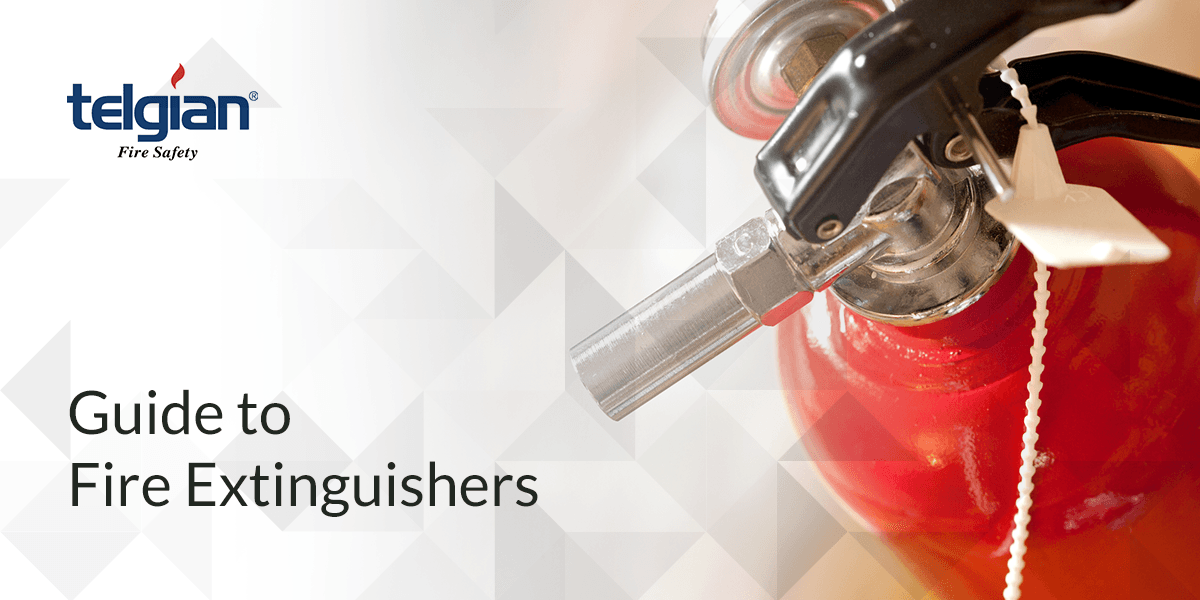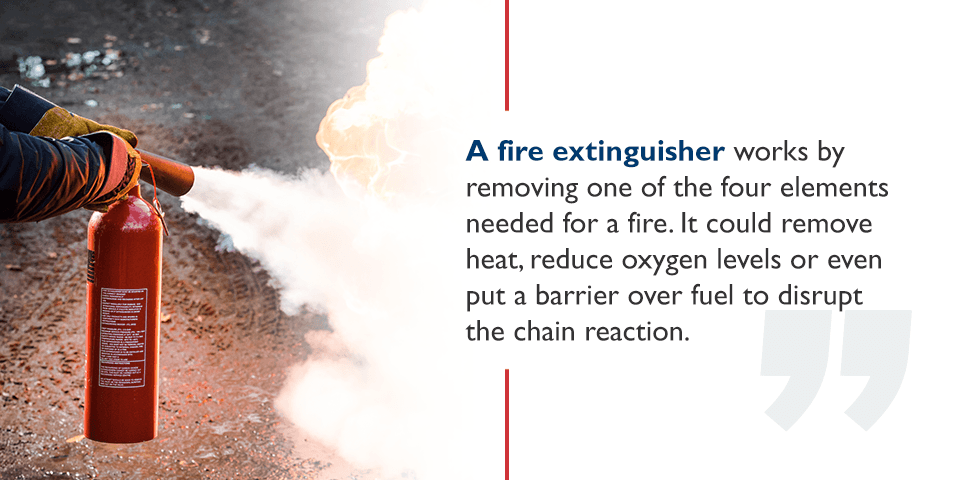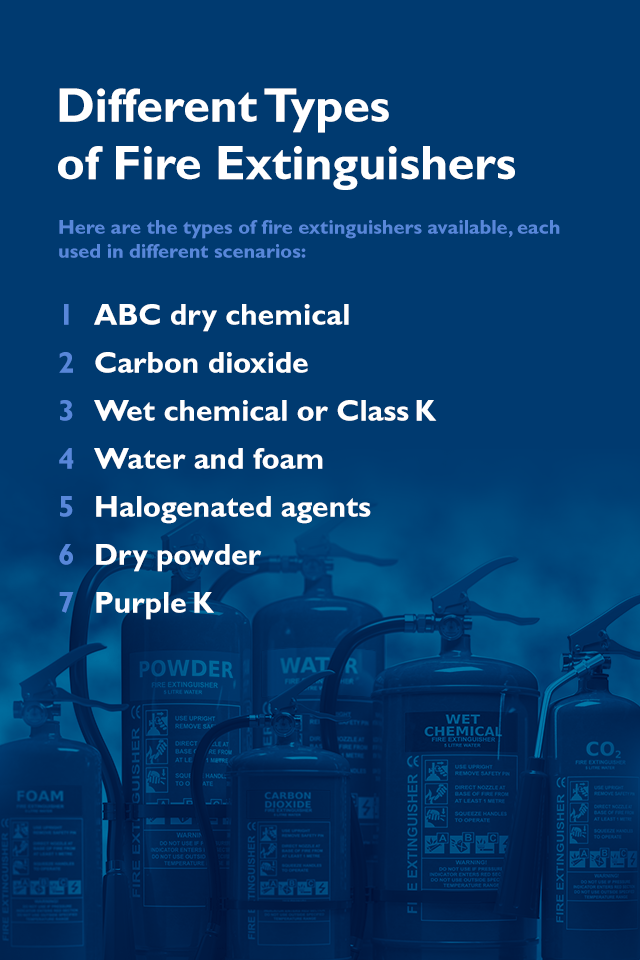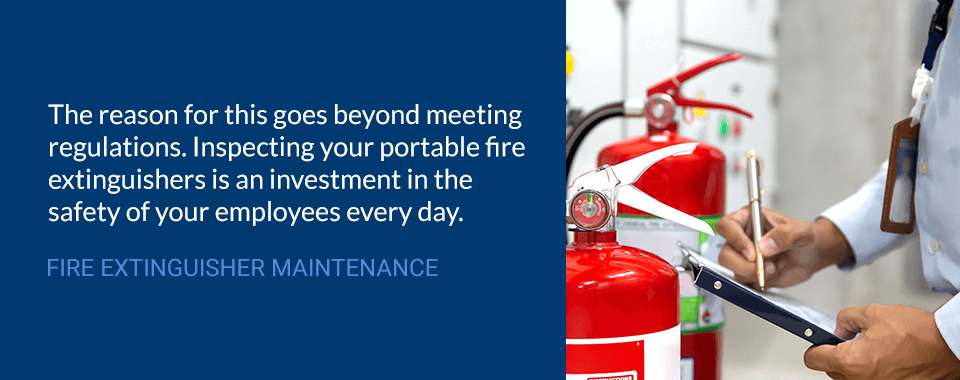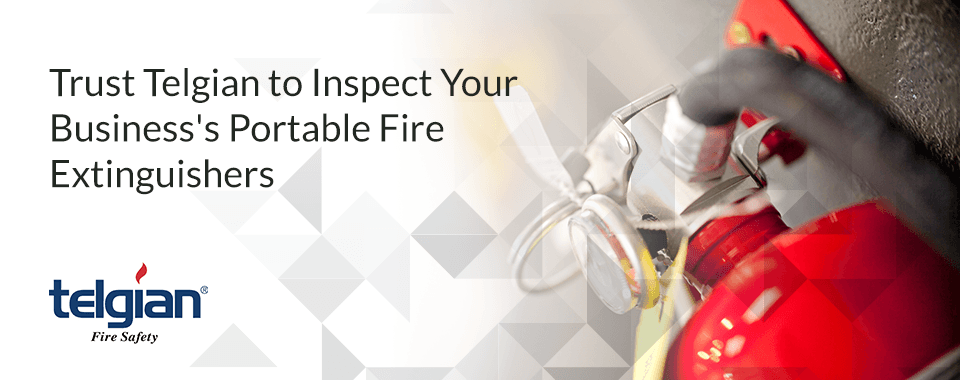Fire extinguishers are an important safety feature in every business. A fire can strike at any time — and some businesses are more at risk than others. While proper evacuation procedures are a must, sometimes you or an employee may need to put out a fire before it spreads. A fire could even block your exit from a burning building. In these situations, fire extinguishers are a must.
But there’s more to fire extinguishers than you might think. Proper maintenance and inspections are a must to comply with regulations. You also need to know which types of fire extinguishers your business should have on hand. Use this guide to learn more about fire extinguishers and how you can use them to keep your business safe and ready for inspections.
How Does a Fire Extinguisher Work?
To know how a fire extinguisher works, you should understand the nature of fire. For a fire to exist, it needs the following four components:
- Fuel
- Heat
- Oxygen
- Chain reaction
Let’s use a classic campfire as an example. You start with firelogs for the fuel. Then, you light a match or use friction to produce heat. And since you’re outside, there’s plenty of oxygen. Since fuel, heat and oxygen are present, a chain reaction begins. This is the phenomenon we call fire.
When you want to put the campfire out at the end of the night, you might dump water over it. What you’re actually doing is taking away the heat and stopping the chain reaction. Likewise, letting the fire burn without adding any more wood will cause the fire to go out. It ran out of fuel, and the chain reaction ceases.
A fire extinguisher works by removing one of the four elements needed for a fire. It could remove heat, reduce oxygen levels or even put a barrier over fuel to disrupt the chain reaction. But not every fire is as simple as a friendly campfire. Across industries, businesses are at risk of a wide range of fires with different fuel sources. You need to know which types of fire you’re dealing with to choose the appropriate fire extinguisher.
Types of Fires
Your area of business affects the types of fires you’re at risk of experiencing. Here are the different types of fires seen across industries:
- Class A: The fuel source for Class A fires involves everyday combustibles. These can include paper, wood, cloth, trash, plastics and vegetation.
- Class B: These fires involve flammable liquids, including grease, lubricating oil, gasoline and paint. These fires can also use gases as a fuel source, such as butane and propane.
- Class C: Class C fires appear on energized electrical equipment. This can include tools, motors, appliances and transformers. If you remove the energy from the equipment, it reverts to another class of fire, such as Class A.
- Class D: Some metals are combustible. Class D fires are ones that light on metals such as zirconium, titanium, magnesium, potassium and sodium.
- Class K: These fires use cooking oils and grease like animal and vegetable fats as a fuel source. They’re most common in kitchen and cooking environments.
Fire Extinguishers: The Basics
Now that you understand the different types of fires, it’s time to take a closer look at fire extinguishers. Just as there are different types of fires, there are also different types of fire extinguishers. Your business will be more at risk of certain types of fires than others, so you choose a fire extinguisher accordingly. You should also understand the parts of a fire extinguisher as well as the different sizes that are available. Here are the basics of fire extinguishers that you need to know.
Different Types of Fire Extinguishers
Water is an easy way to extinguish a campfire, but things become complicated in business environments. Does your business regularly deal with cooking grease? Maybe you and your employees use energized electrical equipment to get the job done. Perhaps you specialize in transporting gasoline or propane. When you get beyond everyday combustibles, you’ll find that water can be ineffective against certain fires. That’s why there are several different types of fire extinguishers to combat different types of fires.
Here are the types of fire extinguishers available, each used in different scenarios:
- ABC dry chemical: You might know these by their familiar red canisters. These common fire extinguishers work by interrupting a fire’s chain reaction. They spray a dry chemical over the fire, creating a barrier between the fire’s fuel and the surrounding oxygen. They’re effective against Class A, B and C fires.
- Carbon dioxide: These extinguishers use carbon dioxide, a non-flammable gas, to put out Class B and C fires. They do this first by replacing oxygen in the air with carbon dioxide, smothering the fire. And since the released carbon dioxide is cold, it combats the heat of a fire to aid in extinguishing it. These extinguishers are ineffective against the hot embers common in Class A fires.
- Wet chemical or Class K: Wet chemical extinguishers specialize in putting out Class K fires. They use an agent that removes heat from the fire to extinguish the flame. Then, the agent creates a barrier between the fuel elements and the oxygen in the air to prevent reignition. These extinguishers are especially useful in commercial kitchens with deep fat fryers.
- Water and foam: These fire extinguishers put out fires in two ways. By applying water to the fire, you remove heat from the equation. Additionally, the sudden, high volume of water removes oxygen from the other elements by smothering the fire. Water fire extinguishers only work against Class A fires. They can spread the flammable liquids and gases of Class B fires and cause an electrical shock in Class C fires. If the extinguisher uses foam, it can work with Class A and B fires.
- Halogenated agents: Halogenated or clean agent extinguishers use halon and halocarbon to extinguish Class B and C fires. They can also work on some Class A fires. These extinguishers work by interrupting the chemical reaction of a fire. And since they leave behind no dirty residue, they’re perfect for clean rooms, offices and storage areas with electrical equipment. The non-conductive halogenated agents won’t cause any electrical shocks.
- Dry powder: Dry powder extinguishers are like ABC dry chemical extinguishers since they use a powder to separate fuel from oxygen. The difference is that dry powder extinguishers are only effective against Class D fires that combust on certain metals. These extinguishers will be ineffective on all other types of fires.
- Purple K: These extinguishers are ineffective against Class K fires, as the misleading name might suggest. Use these extinguishers to put out Class B and C fires. They can extinguish fires involving flammable liquids like petroleum grease, tar, gas and alcohol. They can also fight electrical fires.
The Parts of a Fire Extinguisher
Each type of fire extinguisher will share similar features with other types. Knowing these features will help you in situations when you might need to use a fire extinguisher that you’re unfamiliar with. Here are the parts of a fire extinguisher:
- Mounting bracket: This holds the extinguisher to a wall or column.
- Cabinet: Some fire extinguishers are housed behind cabinets. These protect them from corrosion and damage. You might need a key to open the cabinet, but each cabinet is built to be broken open to retrieve the extinguisher during emergencies.
- Signs: If you’re looking for a fire extinguisher, watch for bright, vibrant signage. These noticeable signs will point to the nearest fire extinguisher so you can spot them in an emergency.
- Tank: The tank houses the extinguisher’s particular fire-fighting agent. It ranges in size.
- Discharge lever: This is the handle on the top of fire extinguishers. Squeeze it to release the extinguisher’s agent through the discharge hose.
- Discharge hose: This connects to the tank and directs the extinguisher’s agent toward the fire. Use this to aim the flow of the substance to extinguish a fire.
- Pull pin: People also refer to this as the “safety pin.” This pin will prevent you from squeezing the discharge lever. You must pull the pin to use the fire extinguisher. It’s usually has a tamper seal that attaches it to the discharge lever.
- Hose strap: This strap holds the discharge hose against the tank when the extinguisher is not in use.
- Pressure gauge: This gauge shows the current level of the extinguisher’s charge. Fire extinguishers have a full charge when not in use. Note that carbon dioxide extinguishers do not have a pressure gauge. Instead, inspectors weigh them make sure they’re full.
Choosing the Right Fire Extinguisher Sizes
Fire extinguishers come in many sizes. Most people are familiar with the classic fire extinguisher hanging on the walls of many businesses and public buildings. These extinguishers are slightly bigger than a two-liter plastic beverage bottle. Yet, several other fire extinguisher sizes exist for use in various situations. They range from handheld sizes to extinguishers needing a cart with wheels to move around.
Knowing which size to use for your business depends on a few factors, including the following:
- Your business’s fire risks: An office fire will likely be smaller than a fire in a manufacturing facility full of hazardous materials. Scale the size of your fire extinguishers to match your realistic risks.
- Business materials and room size: Look at your business space to determine the right size extinguisher for the room. Is it a large storage space housing combustible materials? Or is it a minimalist waiting room with few items that pose a fire hazard? The first room would need a large extinguisher or two, while a single, regular-sized extinguisher is appropriate for the second room.
- The ability and experience of your employees: A fire extinguisher is useless if your employees can’t use it. They should be able to use the nearby fire extinguisher at a moment’s notice. Getting one that’s too big or difficult for your employees to use could result in more danger to them and your business.
How and When to Use a Fire Extinguisher
You and your employees need to know how and when to use a fire extinguisher during emergencies. Every situation is different, so ask yourself these questions before using a fire extinguisher:
- Has someone pulled the fire alarm? Do other people in the building know there’s a fire?
- Has anyone called the fire department?
- Do I have the physical ability to use this fire extinguisher?
- Is the fire small and contained?
- Am I safe from the fire’s smoke?
- Do I have an escape route?
If you’re unsure, your best bet is to evacuate the building and call 911. If you can answer “yes” to the above questions, then you’re ready to use the fire extinguisher. Follow these steps:
- Pull out the safety pin. Make sure the nozzle is facing away from you.
- Aim the discharge hose toward the base of the fire.
- Squeeze the discharge lever slowly. Avoid pumping the lever.
- Use a left-to-right sweeping motion to distribute the agent on the base of the fire.
Fire Extinguisher Maintenance
A fire extinguisher is a mechanical device with several moving components needed to function. For this reason, you must inspect and maintain your fire extinguishers. Inspections should occur every year according to federal, state and local regulations and codes. For instance, stored-pressure-loaded stream and antifreeze extinguishers should be examined once per year, according to NFPA 7.3.3.1.
Note that every six to 12 years, you should perform a more rigorous inspection on your fire extinguishers. You risk violating local laws and regulations if you do not have regular inspections for your fire extinguishers.
The Occupational Safety and Health Administration (OSHA) has its own set of requirements for portable fire extinguishers in businesses. These include the performance and documentation of monthly visual inspections and tests. Failure to perform these inspections can result in fines and other repercussions. It’s your responsibility to make sure you perform these inspections on time. The reason for this goes beyond meeting regulations. Inspecting your portable fire extinguishers is an investment in the safety of your employees every day.
Inspections of portable fire extinguishers include a detailed examination of the following items:
- The fire extinguisher’s mechanical components
- The mounting bracket or cabinet housing of the fire extinguisher
- The discharge hose
- The shell, canister or tank of the fire extinguisher
- The discharge head at the end of the discharge hose
- The discharge lever and condition of the pull pin
If your fire extinguishers pass the inspection, the inspector will apply a tag to the extinguisher. This tag contains information including the date of the inspection and the fire-fighting agent housed within the tank.
Trust Telgian to Inspect Your Business’s Portable Fire Extinguishers
If your company’s fire extinguishers need an inspection, Telgian is the company to call. We inspect and test fire extinguishers at approximately 50,000 locations every year. Though we’re headquartered in Phoenix, Arizona, we serve areas throughout the United States and Canada. We’ll perform every required fire extinguisher inspection you need. This includes helping you stay compliant with NFPA 10, manufacturer requirements and all applicable laws and standards. And since we don’t sell the items we service, you can trust that we’ll perform an unbiased inspection.
Call us at 1-877-TELGIAN to speak to one of our professional representatives. Or contact us online for more information about how we can help keep your business’s fire extinguishers ready for action.
